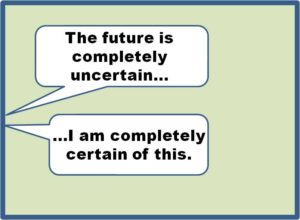An Uncertain Future for Nonprofits
0 comment
Among the many uncertainties of the past two weeks is what a Trump presidency will mean for nonprofits. One of the things you learn very quickly as a student of politics is that what gets promised in any political campaign is likely to change when those promises meet the realities of our political system.
I could rattle off a multiple scenarios for nonprofits in the world of Trump, but they would have as much grounding in reality as trolls and talking fish. In some of these groundless scenarios all is fine with the nonprofit world and with some, it is a scary place for parts of our sector, while not so bad for others.
There are, however, four pieces of advice that I feel fairly confident dispensing.
First, affirm your mission and ensure that all affiliated with your organization—from staff to board to other volunteers—are in alignment with the mission and the organization’s core values. As Jim Collins told us, these two, as the core ideology, keep an organization grounded and on a path to greatness. If the mission statement isn’t clear and specific promise to the public and a solid compass for internal decision-making, now would be a good time to revisit that statement. If those core values aren’t written, well publicized and frequently referred to, again, now is the time to get that all done.
Second, regardless of whether anything happens to the charitable tax deduction, it isn’t going to impact the vast majority of nonprofits. Unless you are a hospital, college or university or a major arts organization (by which I mean an orchestra, ballet or museum that is fairly to very well renowned) or have something for which you can sell the naming rights for a big price tag, the presence or absence of the charitable tax deduction or an increase or decrease in the threshold isn’t going to really matter to your individual giving. What economists tell us is that the amount of individual giving has remained fairly constant over past decades at 1.83% of personal income, despite fluctuations in federal tax rates. Should we move to a flat tax, pundits tell us that donations to nonprofits will go up because personal income will go up: by paying a flat tax, we keep more money for ourselves and, thus, have more money to give to charities. These same people also point out that should the charitable deduction fall by the wayside, there is still no cause to worry as personal wealth will still have increased, leaving more money to donate to good causes. And, research shows that the charitable deduction is a low ranking reason why people give to charities, with wanting to help/make a difference and personal satisfaction topping the list of reasons why folks give. People say they would give the same amount to charities, with or without the charitable deduction. But none of this negates the fact that every nonprofit should ensure that it is a comprehensive, diversified development strategy for each of its programs and the organization as a whole.
Third, be sure your core competencies are in good shape. Yes, of course, your core competencies should always be in good shape, but just in case you’ve gone a little lax, check them. In tough times, nonprofits should always be able to count on their core competencies to see them through. And there may be tough times ahead for some because their mission work will go underfunded or the need and demand for their mission work will skyrocket, or plummet. Regardless, we should always be able to say “this is what we do better than anyone else,” as clients want services from the best, donors want to give to the best, employees want to stay working for the best, etc. If the times get rough for your nonprofit in the years to come, strong core competencies should carry you through the tough times.
Fourth, be proactive and engage in scenario planning now. Given how much we don’t know about what may or may not happen, boards would be well-advised to do some serious consideration of multiple scenarios for their organizations in light of different ways the future might evolve. As we get more insight into who will populate the cabinet seats, heads of regulatory organizations and positions of high advisors, we will be able to anticipate the alternative directions things might go. Rather than sit back and wait until the future arrives and we are the proverbial deer in the headlights, nonprofits should be planning now for the various possibilities. That way, when the future is now, we are ready with a course of action.
These are uncertain times. But rather than sit around wringing our hands, we should—and must—be doing the things that will help us come out the other end minimally intact, if not optimally thriving.
The opinions expressed in Nonprofit University Blog are those of writer and do not necessarily reflect the opinion of La Salle University or any other institution or individual.

